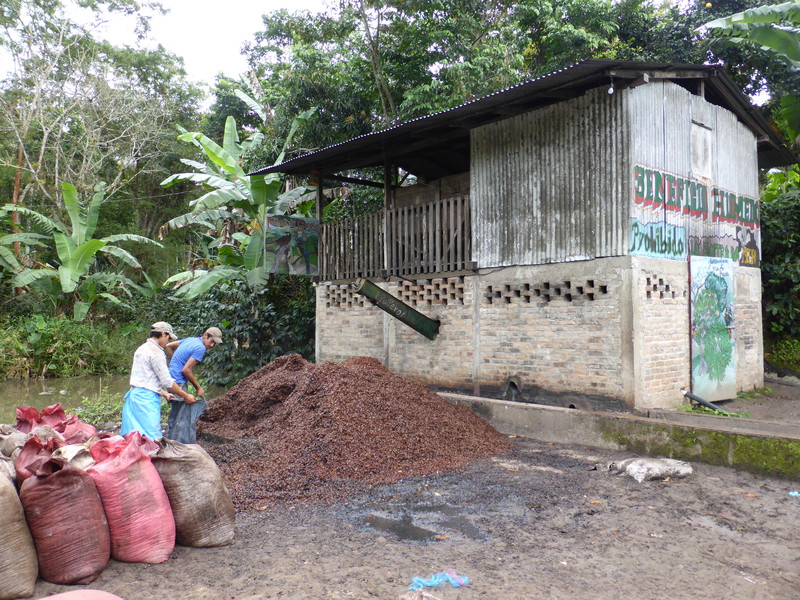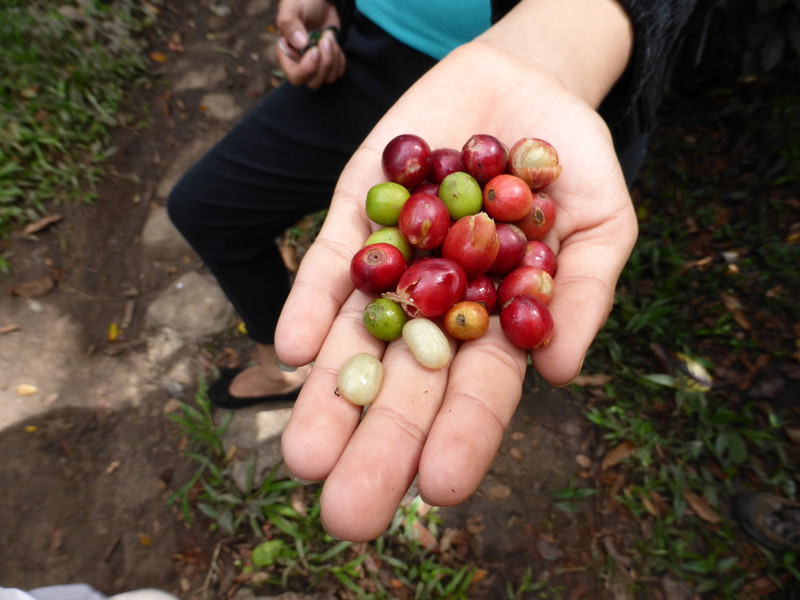
I remember visiting Darjeeling during my trip to India back in 1998, not just because of the wonderful views and mountain air (which were excellent and a welcome change from the sweaty plains of the subcontinent), but because it was my first introduction to the way that tea is made. Up to that point I'd been perfectly happy with a good old cup of builder's tea, but as soon as I discovered the delights of Super Fine Tippy Golden Flowery Orange Pekoe, I was hooked. Ever since then I've looked out for and enjoyed good quality tea (though that doesn't mean I can't enjoy a nice cup of PG Tips, of course; I'm no tea snob).

After visiting Matagalpa, I think the same thing might happen with coffee, because this is one of the four main centres along the Nicaraguan Ruta de Café (the others being Jinotega, Estelí and San Raphael del Norte). Nicaragua is the 12th biggest coffee producer in the world and is known for producing high quality coffee, so we eagerly booked ourselves on a day-long coffee plantation tour through Matagalpa Tours (who provide English-speaking guides, a bit of a must with our dodgy Spanish). The following morning we were picked up by our guide, José, and our driver, Juan Ramon, and we headed off through the light rain to the coffee-growing community of La Corona, and into a whole new world of coffee appreciation.
Growing Coffee

The little settlement of La Corona, a few miles to the northeast of Matagalpa, is home to a cooperative of small coffee farms, and we bumped our way along dirt tracks to visit one of them and to learn about how coffee is grown. There we met Karla, one of the six children (five daughters and a son) of the farm owners, who themselves had met while picking coffee. Karla talked us through the process of growing coffee, with José interpreting, and it turns out that an awful lot of effort goes in to producing your morning brew, from the bean all the way to the cup.

Coffee plants in Nicaragua are grown from specially selected coffee beans of the arabica strain (of the two main strains of coffee, arabica and robusta, this is the higher quality strain). Beans destined for the nursery are picked from the middle section of the coffee plant, and from the middle part of the branches in that section. They are picked when they are ripe, at which point they look like red berries (they're called 'cherries' at this point); if you peel off the skin, which is not unlike thick grape skin, then there's a clear pulp underneath that's not unlike the inside of a firm grape, or a lychee. Inside the pulp you can fine two identical coffee beans, which look a bit like slime-covered peanuts. You can peel ripe beans and suck off the pulp, and it tastes sweet, though there's no hint of any coffee flavour at this point. There is caffeine, though, so sucking coffee cherries is a mild stimulant that pickers will use to keep them going through the day.

To get beans that are suitable for growing, 100 beans from the same plant are put in water, and if more than five beans float, then all that plant's beans are rejected. Otherwise the pulp is carefully removed from each bean and the beans are left to ferment, which removes the rest of the pulp, and they're then washed, dried and stored for up to four months before being germinated and planted. When the seedlings are a couple of inches high – at which point they are called 'matches' because the bean casings get pushed up to the top of the seedlings, like a match head – they are removed from the soil, and only those with single roots are kept. These are then planted and watered, and after three or four years the resulting plants are mature enough to start producing their own coffee beans.

Interestingly, the better coffee plantations in Nicaragua look more like forests than fields of crops. Karla's farm grows coffee that thrives in shade, so they also plant bananas, cocoa and other tall trees to provide shelter from the sun. This also provides a secondary crop for the farmer, as well as producing a higher quality coffee (shade-dwelling coffee plants tend to produce lower yields than those grown in full sunshine, though the coffee is better). They also recycle the water that's used to wash the beans, they only use organic pesticides, and they reuse all the by-products of the farming process; these are just some examples of what farmers have to do to get accredited by the schemes that ensure higher prices for their crop, such as the Rainforest Alliance, Starbucks, UTZ or Fair Trade.
Harvesting the Beans

Coffee plants are harvested once a year, though the plants flower two or three times a year. Each flower produces one cherry, and all the cherries have to be picked, even if they aren't good enough to be used, as otherwise the flowers won't regrow. Ideally coffee cherries are picked when they are ripe and red, as these are easiest to process, though cherries can also be picked when they are green; the taste isn't affected, but green cherries have to go through an extra fermentation process before the skin can be removed.

On the farm we visited, the cherries are picked by hand, using a twisting motion that leaves the stem behind, ready to flower again. Workers strap woven baskets to their stomachs and drop the berries in as they pick them; they get paid 30 córdobas per basket (about 70p), and an average worker will fill five or six baskets a day (though some manage up to 12, while others only manage two or three). They work an eight-hour shift and get paid twice a month for the amount they've picked, and when they're not picking cherries, they're sorting them out into red and green, and picking out any dead or diseased cherries. It's a hard life for little reward.

Once picked, the cherries are put through a four-step process (in the 'wet mill') to produce a coffee bean that's suitable for the next stage (the 'dry mill'). First, they are put into water where bad cherries float to the surface and are discarded; next, they are fed into a de-pulping machine that strips off the outer skin (which is then used for fertiliser); then they are pumped into fermentation vats, where they ferment until the pulp is dissolved; and finally, the beans are washed thoroughly in a special channel which not only removes the fermented pulp, but also separates the beans according to quality: the best quality beans are heavier and therefore don't wash away so easily, while the lower quality beans are lighter and wash away first.
These bags of fermented coffee beans, which stink to high heaven, are then sold to an agent, who sells them to the dry mill to prepare for export. The farmer might sell a bag – which contains four buckets – for US$50, which the agent sells on for US$200, and which the dry mill exports for US$1000. The farmers are clearly not the winners in this game, which is one of the reasons Fair Trade exists, to ensure that the farmers at least get a relatively fair price.
Dry Roast

After a pleasant lunch on the coffee farm, we drove back through Matagalpa to visit a dry mill. You see these dry mills all along the main roads in this part of Nicaragua; they are huge, flat, open spaces with coffee beans covering every flat surface, as far as the eye can see. The dry mill that we visited, Beneficio Los Piños, has four distinct areas of drying beans: the best quality beans are in the hybrid area, where speciality strains dry on their own concrete patio; then the first quality beans cover a larger concrete area, drying in carefully raked rows directly on the concrete; just below that is the second quality area, where the yellow beans dry on large plastic sheets on concrete patios; and finally there's the lowest quality area, where dark brown piles of damaged beans and dried cherry skins steam away on plastic sheets on grass.

The difference between the different qualities of beans is striking. The hybrid and first quality beans are all perfectly formed, with the classic coffee bean shape and a uniformly light yellow colour; the second quality beans are a little smaller and a bit more misshapen, and the piles contain quite a few damaged beans; and finally the lowest quality pile contains a handful of mangled beans (which go to make instant coffee) and bean husks (which the Nicaraguans use for their own coffee, as this is the only way to make it affordable for the locals).

The final part of the dry mill process is to remove the thin layer of yellow skin from the bean (known as the 'parchment'), and to dry the bean even further until it is ready for exporting. This is done by machine, first by a gargantuan rotating drum that has hot air blown through it; the beans are fed into this drum and bounce around for 24 hours, which dries the parchment and reduces the humidity in the bean right down. Next the beans are fed onto a vibrating conveyor belt that removes the now-dry parchment and separates it from the beans, and finally the beans are sorted into different sizes, and then by colour (which is done electronically, though this used to be done by hand).
The beans are then ready to export. Nicaragua doesn't export roasted beans, as the aroma gets lost in transit, but luckily for us, Beneficio Los Piños has its own on-site laboratory where they test the quality of the beans. The only way to do this is to drink coffee made from those beans, so after touring the factory, we stepped into the small laboratory and into the wonderful smell of roasting coffee.

The chief tester, Alexander, showed us how it's done. He spends his days gathering samples of beans from the concrete flats, drying them himself and removing the parchment. He then roasts the beans in a small roasting oven, grinds them up in the grinder, puts the results in the bottom of a white cup, pours on hot water, and waits. He has a round table in the lab that rotates like a table in a Chinese restaurant, so on busy days he will lay out lots of samples, spinning them round to compare tastes. For us, he just picked out one sample, and demonstrated how you first break the froth on top to let out the aroma, bending down close to the cup to get the full effect. Once the aroma has been noted, you scoop off the froth and discard it, wash your mouth out with hot water, and then take a spoonful of coffee and suck it through pursed lips with a loud whooshing sound, before swilling it around and spitting it out into the bucket under the table.
'That's good,' he said. 'You can taste the chocolate notes in there. Give it a go.'
To be fair, I couldn't taste the chocolate notes, but the coffee certainly tasted good, even though my attempts to emulate Alexander's whooshing noise ended up sounding more like a pig with a head cold.
And with that we hopped back in the car and went back to the hotel, swearing never again to drink instant coffee.